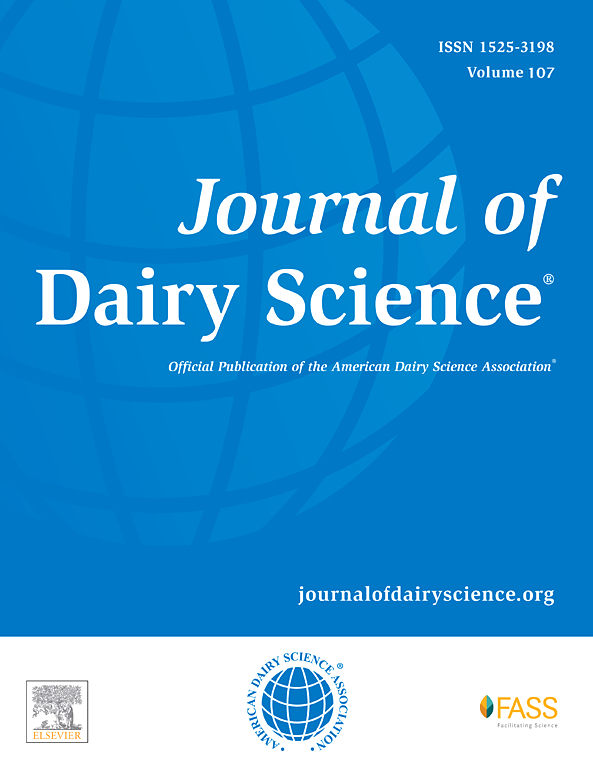利用首次授精前采集的牛奶中红外光谱和机器学习算法预测奶牛受孕的可能性。
IF 3.7
1区 农林科学
Q1 AGRICULTURE, DAIRY & ANIMAL SCIENCE
引用次数: 0
摘要
根据牛奶成分信息对奶牛受孕可能性(LC)进行准确的事前预测,可改善奶牛场的繁殖管理。牛奶成分已通过中红外(MIR)光谱进行常规测量,众所周知,中红外光谱会随着怀孕阶段的推进而发生变化。对于泌乳奶牛,中红外光谱也可用于预测LC。我们的目标是利用从产仔到首次授精期间收集的牛奶中红外光谱数据对首次授精时的低泌乳量进行分类,并确定对预测首次授精时的低泌乳量贡献最大的光谱区域。经过质量控制后,使用了来自 3,451 头荷斯坦奶牛的 4,866 个近红外光谱、产奶量和繁殖记录。对由不同预测因子和 3 种机器学习方法组成的 6 个模型的分类准确率和曲线下面积(AUC)进行了估算和比较。结果表明,偏最小二乘判别分析(PLS-DA)和随机森林的预测准确率高于逻辑回归。最佳模型的良好和不良LC奶牛分类准确率以及逐群验证的AUC分别为76.35±10.60%和0.77±0.11。在 PLS-DA 中,投影重要度变量值大于 1.00 的所有波数均属于 3 个光谱区,即 1 003 至 1 189、1 794 至 2 260 和 2 300 至 2 660 cm-1。总之,该模型可以在人工授精前预测高产TMR系统奶牛的LC值,且准确性较高,以便奶农提前干预或调整LC值预测较差的奶牛的人工授精时间。本文章由计算机程序翻译,如有差异,请以英文原文为准。
Prediction of likelihood of conception in dairy cows using milk mid-infrared spectra collected before the first insemination and machine learning algorithms
Accurate and ex-ante prediction of cows' likelihood of conception (LC) based on milk composition information could improve reproduction management on dairy farms. Milk composition is already routinely measured by mid-infrared (MIR) spectra, which are known to change with advancing stages of pregnancy. For lactating cows, MIR spectra may also be used for predicting the LC. Our objectives were to classify the LC at first insemination using milk MIR spectra data collected from calving to first insemination and to identify the spectral regions that contribute the most to the prediction of LC at first insemination. After quality control, 4,866 MIR spectra, milk production, and reproduction records from 3,451 Holstein cows were used. The classification accuracy and area under the curve (AUC) of 6 models comprising different predictors and 3 machine learning methods were estimated and compared. The results showed that partial least square discriminant analysis (PLS-DA) and random forest had higher prediction accuracies than logistic regression. The classification accuracy of good and poor LC cows and AUC in herd-by-herd validation of the best model were 76.35% ± 10.60% and 0.77 ± 0.11, respectively. All wavenumbers with values of variable importance in the projection higher than 1.00 in PLS-DA belonged to 3 spectral regions, namely from 1,003 to 1,189, 1,794 to 2,260, and 2,300 to 2,660 cm−1. In conclusion, the model can predict LC in dairy cows from a high productive TMR system before insemination with a relatively good accuracy, allowing farmers to intervene in advance or adjust the insemination schedule for cows with a poor predicted LC.
求助全文
通过发布文献求助,成功后即可免费获取论文全文。
去求助
来源期刊

Journal of Dairy Science
农林科学-奶制品与动物科学
CiteScore
7.90
自引率
17.10%
发文量
784
审稿时长
4.2 months
期刊介绍:
The official journal of the American Dairy Science Association®, Journal of Dairy Science® (JDS) is the leading peer-reviewed general dairy research journal in the world. JDS readers represent education, industry, and government agencies in more than 70 countries with interests in biochemistry, breeding, economics, engineering, environment, food science, genetics, microbiology, nutrition, pathology, physiology, processing, public health, quality assurance, and sanitation.
 求助内容:
求助内容: 应助结果提醒方式:
应助结果提醒方式:


